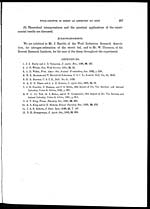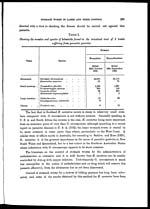Medicine - Veterinary > Veterinary colleges and laboratories > Indian journal of veterinary science and animal husbandry > Volume 4, 1934 > Original articles > On the incidence of stomach worms in lambs in the north of Scotland and their control by progressive sectional grazing
(298) Page 268
Download files
Individual page:
Thumbnail gallery: Grid view | List view

ON THE INCIDENCE OF STOMACH WORMS IN LAMBS IN THE
NORTH OF SCOTLAND AND THEIR CONTROL BY PROGRES-
SIVE SECTIONAL GRAZING.
BY
DAVID ROBERTSON, PH.D. B.Sc. (AGR.), N.D.A.,
Lecturer in Agricultural Zoology, North of Scotland College of Agriculture
AND
ALLAN H. H. FRASER, M.D., M.B., CH.B., B.Sc.,
Rowett Research Institute, Aberdeen.
(Reprinted from the Journal of Helminthology, Vol. XI, No. 4, October 1933)
INTRODUCTION.
Recent investigations carried out by the senior writer on the incidence of para-
sitic helminths in the alimentary tract of sheep in the north of Scotland have
demonstrated heavy losses in lambs due to parasitic gastritis. In the autumn
of 1932 six severe outbreaks were recorded in the counties of Kincardine, Aberdeen
and Moray, but no doubt this number would have been greatly exceeded had it
been possible to make a comprehensive survey. Some idea of the severity of the
disease may be judged by the fact that several farmers lost from 10-20 per cent. of
their lambs.
The usual predisposing cause was observed in each case, namely, over-stocking
attended by failure to move the lambs on to fresh ground when symptoms of
parasitic infestation were apparent.
Postmortem examination of diseased lambs revealed that the lesser stomach
worm, Ostertagia circumcincta was present in very much larger numbers than any
other parasite. O. trifurcata sometimes occurred in small numbers but no attempt
was made to separate the two species. The Table below gives the numbers and
species of helminths found in two typical cases of parasitic gastritis.
A further 6 untreated lambs from different areas were autopsied but no record
of the actual numbers of worms present was taken. A close examination of the
abomasum contents was made, however, and in each case the number of O. circum-
cincta far exceeded that of H contortus or any of the intestinal worms found
present. It may, therefore, be concluded that parasitic gastritis in lambs in the
north of Scotland is mainly due to O. circumcincta and that any control measures
(268)
Set display mode to: Large image | Zoom image | Transcription
Images and transcriptions on this page, including medium image downloads, may be used under the Creative Commons Attribution 4.0 International Licence unless otherwise stated. ![]()
| Permanent URL | https://digital.nls.uk/75234610 |
|---|
| Description | Covers articles from 1934. |
|---|




